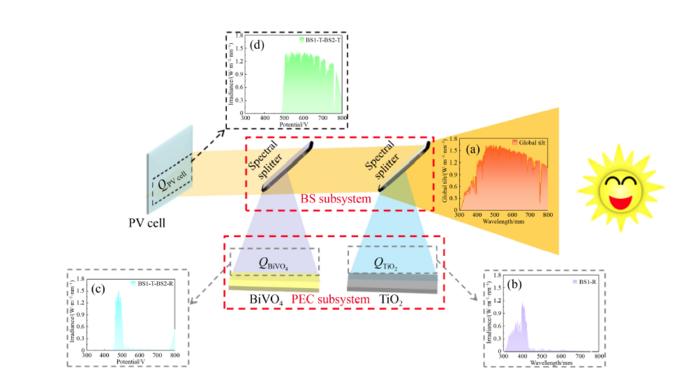Photoelectrochemical (PEC) water splitting is emerging as a transformative method for harnessing sunlight to produce hydrogen fuel, bringing us closer to a sustainable future powered by clean energy. This innovative approach could drastically alter our energy landscape, especially as society grapples with the pressing need for renewable energy sources due to ongoing climate challenges. However, conventional PEC systems have significant drawbacks, including low efficiency and the requirement for additional voltage, which has limited their practical applications. Researchers are now taking groundbreaking steps to overcome these obstacles, creating hybrid systems that combine PEC technology with photovoltaic (PV) cells for improved energy conversion.
At the forefront of this research is a team led by Professor Jinzhan Su at Xi’an Jiaotong University. They have developed a pioneering self-biased hybrid system that incorporates spectral beam splitters (BSs) to optimize how sunlight is utilized within the system. The design involves directing specific parts of the solar spectrum to various components, including specialized photoelectrodes made of TiO2 and BiVO4. Each of these materials is adept at absorbing distinct regions of the solar spectrum, allowing for greater efficiency in energy capture and use.
The results from the research are compelling, showcasing a remarkable achievement in the field of solar-to-hydrogen conversion. The hybrid system with spectral BSs has surpassed traditional tandem PEC systems, boasting a current density that is notably higher. The intersection point of the I-V curves for the photoanodes and solar cell is remarkably closer to the solar cell’s maximum power output, indicating that both components are operating closer to their peak efficiencies, thereby optimizing overall energy production.
What sets this innovative hybrid system apart is not just the current density but also the impressive power output it achieves. The study details that this advanced system generates power outputs that are 18.8 times greater than those observed in conventional TiO2 and BiVO4-PV systems. Such a substantial increase in performance suggests that this new method could play a crucial role in furthering the development of clean hydrogen fuel technologies.
As the research progresses, the implications of these findings extend beyond current limitations in PEC technology. The enhanced performance driven by the integration of spectral BSs signifies a substantial shift in how researchers can approach the optimization of solar-driven systems. The study shines a light on the necessity for further exploration and refinement of photoelectrode materials and the configuration of PV cells, suggesting that even more significant improvements in efficiency may lie ahead.
The hybrid system documented in this study thus not only promises to advance our understanding of photoelectrochemical processes but also serves as a potential pathway toward sustainable and efficient large-scale hydrogen production applications. With the global community seeking innovative energy solutions, this technological advancement could be pivotal in meeting energy demands while reducing carbon footprints.
This novel hybrid approach could redefine the landscape of solar energy technologies, ushering in an era where clean hydrogen fuel becomes a staple in energizing our cities and industries. The innovations stemming from this research open doors to practical applications that will support energy transition goals and combat climate change by providing an efficient, renewable hydrogen production pathway.
As expertise in these hybrid systems grows, so too does the prospect for integration into existing energy infrastructures, potentially revolutionizing how we think about energy generation and consumption. The collaborative nature of such scientific research emphasizes the importance of interdisciplinary partnerships to push boundaries and solve complex energy challenges.
Ultimately, this research stands as a testament to human ingenuity and our relentless pursuit of sustainable solutions. By merging the realms of photovoltaic technology and photoelectrochemistry, we inch closer to achieving a cleaner, greener future powered by renewable energy sources, significantly altering the trajectory towards hydrogen fuel industrialization.
The advancements witnessed in this study are just a glimpse of the possibilities that lie ahead. With further investment and research, the components, processes, and materials used within this hybrid system could lead to breakthroughs that not only enhance efficiency but also reduce costs, making clean hydrogen fuel more accessible than ever.
In conclusion, the self-biased hybrid system employing spectral beam splitting presents a significant leap forward in PEC water splitting technology. It highlights the potential of engineering solutions that effectively harness solar energy for sustainable applications, emphasizing a transformative vision for our future energy landscape.
Subject of Research: Not applicable
Article Title: Performance analysis of a novel unassisted photoelectrochemical water splitting hybrid system based on spectral beam splitting
News Publication Date: 14-Feb-2025
Web References: http://dx.doi.org/10.1007/s11708-025-0984-6
References: Not applicable
Image Credits: Baoyuan Wang, Suyi Yang, Tuo Zhang, Yukai Liu, Sheng Yang, Luning Li, Weiding Wang, Jinzhan Su
Keywords
Energy, Photoelectrochemistry, Hydrogen Production, Renewable Energy, Solar Energy, Spectral Beam Splitting, Hybrid Systems.
Tags: BiVO4 materials for energyclean energy innovationsclimate change mitigation strategiesenergy conversion efficiencyhybrid energy systemsphotoelectrochemical water splittingrenewable hydrogen productionself-biased PEC systemssolar energy optimizationspectral beam splitting technologysustainable energy solutionsTiO2 photoelectrodes





